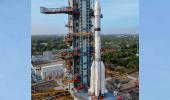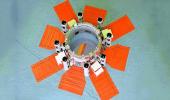'The satellite's condition is healthy.'

The Indian Space Research Organisation has suffered a setback as its latest navigation satellite NVS-02 will not reach its intended slot to provide full services owing to the failure of the pyro valve, the first of its kind failure.
This puts into question the efficacy of India's NavIC -- Navigation with Indian Constellation -- system.
It also sounds a warning bugle for ISRO as the same type of pyro valves will be used in the proposed human flight mission Gaganyaan.
The 2,250 kg NVS-02 costing about Rs 300 crore (Rs 3 billion) that was placed in the Geosynchronous Transfer Orbit (GTO) on January 29, 2025 is stuck there as its pyro valve did not open to pump in the oxidiser to fire the motors.
Only the fuel supply to the motors was present, but without the oxidiser the fuel cannot burn.
"It is a first of its kind failure which was not supposed to happen. Such a failure has not happened earlier for Indian satellites," a retired ISRO scientist explained.
"The same pyro valves are slated to be used for the proposed Indian human flight mission. It is time for ISRO to further tighten up its quality control aspects," the retired ISRO official added.
The NVS-02 was orbited by the Geostationary Satellite Launch Vehicle (GSLV) costing about Rs 300 crore, the retired senior official, speaking on the condition of anonymity.
Interestingly, it was the 100th rocket launch at the Sriharikota spaceport.
Usually, a geostationary satellite's orbit would be to its final position -- the geostationary orbit -- within two or three days after it was put into GTO.
The satellite's orbit would be raised by firing the liquid apogee motors (LAM).
However, for four days, ISRO has been silent on the orbit raising activities.
Only at the fag end of the fifth day did ISRO state that the orbit raising operations towards positioning the NVS-02 to the designated orbital slot could not be carried out as the valves for admitting the oxidiser to fire the thrusters for orbit raising did not open.
'The satellite systems are healthy and the satellite is currently in elliptical orbit. Alternate mission strategies for utilising the satellite for navigation in an elliptical orbit is being worked out,' ISRO said in a statement.
The satellite was stabilised in GTO using its gyro wheels. One of the reasons said for the pyro valve not opening is there could be a fault with the electrical connector, it is learnt.
"We will be raising the orbit using the thrusters with the available propellant. The satellite's condition is healthy," ISRO Chairman Dr V Narayanan told this reporter. "The satellite will be used for navigation purposes only."
When asked about the pyro valve failure Dr Narayanan reiterated that the satellite would be raised using the thrusters.
However. experts are sceptical and said the satellite could not be raised to geostationary orbit with the thrusters.
If the pyro valve does not open then the NVS-02 satellite will not be used for navigation purposes nor could be used as an earth observation satellite as the necessary payloads are not there, experts said.
The satellite's perigee may be raised using the fuel but it may not result in a major benefit, the experts added.
Perhaps the satellite could be used for messaging and testing the India-made atomic clocks, a retired ISRO official remarked.
Venkatachari Jagannathan can be reached at venkatacharijagannathan@gmail.com











 © 2025
© 2025